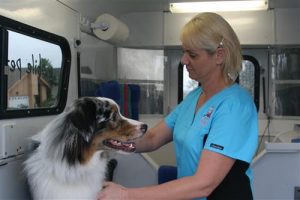 The cooler weather is a wonderful change of pace, but just like in humans, even slight changes in the weather can wreak havoc on your dog’s skin and coat. Most pet parents find it rather surprising. In fact, one of the most common grooming questions we hear from many of our fabulous pet parents is why the coat and skin changes so much when winters in San Diego are not at all harsh. The truth is – it really does not take much of a change in the temperature or weather to cause your pal’s skin and coat to react in a big way.
The cooler weather is a wonderful change of pace, but just like in humans, even slight changes in the weather can wreak havoc on your dog’s skin and coat. Most pet parents find it rather surprising. In fact, one of the most common grooming questions we hear from many of our fabulous pet parents is why the coat and skin changes so much when winters in San Diego are not at all harsh. The truth is – it really does not take much of a change in the temperature or weather to cause your pal’s skin and coat to react in a big way.
Winter Zaps Moisture
You probably notice how dry, cracked and uncomfortable your skin becomes in winter. The same is true for your furfamily. Frequent changes in temperature, rain, and wind as well and atmospheric changes in moisture levels in the air both indoors and out can cause the skin to become dry, cracked, and painful. Even some of the things we do (or how we do them) such as how we bathe them, can contribute to the problem. For us, the problem is easily solved with daily moisturizing. For our fur family, it may take a few more steps and a bit of detective work.
Things that Contribute to Winter Skin and Coat Problems
- Improper over and under bathing
- Lack of proper grooming
- Forced heating and drier indoor climate
- Staying wet too long
- Rain, wind, and cold
- Nutritional balance
- Not staying hydrated
-
Seasonal allergies
Dry Skin can Cause Big Problems
Dry skin and coat, and the things that contribute to them, can be a bigger problem than most pet parents realize. Once the skin becomes dry or cracked, your dog will try to alleviate their discomfort by scratching and rubbing up against things which can cause the cracked skin to become even more damaged. They may roll in dirt to itch their backs and in the process pick up bacteria and parasites that can cause sickness and infection. The coat may become dull, patchy, and uneven. The fur may also loose the natural oils that helps protect the skin from bacterial and parasites.
 How To Protect Your Dog’s Skin and Coat
How To Protect Your Dog’s Skin and Coat
- Tell the mobile groomer you noticed dry skin. The groomer can take extra measures to condition the coat and skin such as using moisturizing shampoos and conditioners, and applying a moisturizing wrap.
- Home bathe with extra care. Over bathing, under bathing, using the wrong products, the wrong temperature water and not drying properly can all cause serious skin and coat problems, especially in winter.
- Keep the dog’s coat well groomed. If the coat is long or unbrushed, it is more likely to retain moisture and dirt which will attract bacteria and parasites. Ask the groomer about deshedding and how to maintain the coat between mobile grooming appointments.
- Use a humidifier in the home. Heating the home takes the moisture out of the air which can cause skin and fur problems in your dog. Try using a humidifier and keeping the keeping the home a little cooler to maintain the mo0isture in the home.
- Provide shelter outdoors. If your dog spends time outside, provide a cozy shelter from the elements.
- Maintain good nutrition. Nutrition plays a huge role in the condition of your dog’s coat and skin. Talk to the family veterinarian and ask about any dietary changes that might be helpful to you faithful friend.
- Make sure your dog stays well hydrated. Drinking enough water is important to keeping the coat and skin healthy.
- Cover up! Even a breeze can take the moisture out of your dog’s delicate skin. If you are going off on an adventure, consider covering your pup up with a vest, windbreaker, or other cover-up.
- Talk to the vet about adding fish oil supplements to your dog’s diet. Fish oil supplements contain the essential vitamins and Omega fatty acids dogs need to maintain a beautiful coat and healthy skin.
- Consider other reasons for dry skin. Talk to your vet about ruling out other reasons for dry skin like allergies or other medical conditions.
If you have any questions about how to maintain your dog’s coat and skin this winter, please do not hesitate to contact us!
